We drove a lot of cars in 2021, we’re reposting a few of our favorites here.
The 2022 Ford Maverick is one of those rare vehicles that almost impresses me more for what’s not there than what is there. That’s because what’s not there is something that’s pervasive in not just the automotive world, but so many aspects of life: bullshit. The bullshit content of the new Maverick is near zero. When the bullshit is stripped away, what’s left behind is an extraordinarily clever, honest, flexible, practical, efficient, and appealing machine, and that machine is even cheap. I really like what the Maverick is.
(Full disclosure: Ford flew me to Nashville to drive the new Maverick, fed me and gave me booze on a rooftop with the widest bus I’ve ever seen, and refrained from calling me names like “Chockfull Dampdiapers”, at least to my face. Also, as you can see in the pictures, I managed to sneak out to the fantastic Lane Motor Museum.)
The Maverick isn’t trying to be anything it isn’t, which it really shouldn’t even feel the need to, because it’s a little tricky to pin down what exactly it is.

I know Ford considers the 2022 Maverick a truck, and while it certainly is that, I think the best way to see the Maverick is less of a truck, and more of a remarkably flexible and usable multi-purpose vehicle. I say this because for many people “truck” still has connotations that would suggest specific uses, and the Maverick is really a master of flexibility.
This is also why I’m not all pissy that the Maverick doesn’t come in a traditional small-truck single-cab option. That’s because part of what makes the Maverick great is how many things it manages to be: a five-seat family car with plenty of interior room; a truck with a usable, open bed; a near-Prius-level hybrid fuel miser; a commuter; a road trip car; an adventuring platform; a hobby and work enabling tool; a farm car you can comfortably transport multiple goats in; and more.
In a lot of ways, it reminds me of another machine that always felt like a sort of Swiss Army knife of a vehicle, something that could do just about any task, if people could get over their silly ideas about status and maybe be more accepting, aesthetically:

The Maverick has all of the abilities of a smallish, double-cab pickup with a bit of extra enclosed storage like that old VW, but comes in a package that’s much more acceptable to mainstream, modern buyers.
If you combine all of the things the Maverick is capable of doing and add in the remarkable fuel-efficiency of the base hybrid model and the starting price of $19,995, then the real question becomes why the hell would anyone want to buy a crossover like the Toyota RAV4 or the Honda CR-V, two of the best-selling vehicles in America?
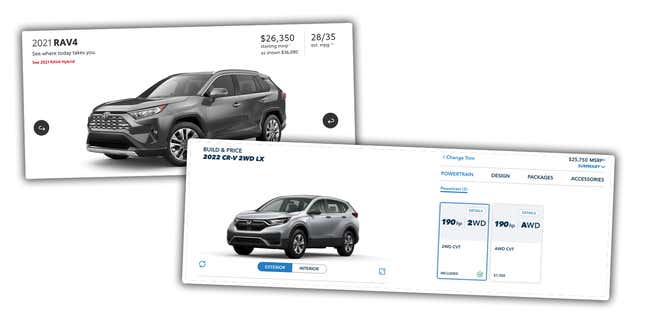
Compared to the base hybrid Maverick, both the RAV4 and CRV are close in power (Maverick is 191 horsepower, Honda is 190, Toyota is 203), both the CR-V and the RAV4 get over 10 mpg less in the city, and both cost around $6,000 more.
If you want to compare hybrid apples to hybrid apples with the Toyota, you can, but then you’re paying around $8,000 more.
And, really, what are you getting for all that extra money? A car that’s easier to lose in the Target parking lot? A car that is significantly less flexible and capable? Less ability to tow things, if you wanted to? More boredom?
Sure, the crossover’s cargo areas are enclosed, but if that’s important, I’ve already seen pictures of Ford’s upcoming camper shell for the Maverick, and it looks pretty good:
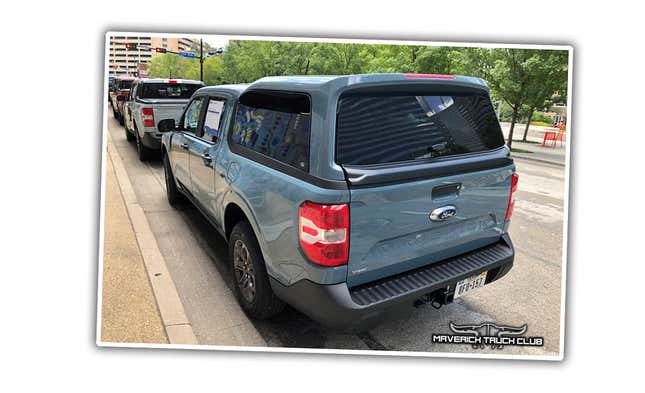
What I’m saying here is that I think the Maverick should be considered not just by people who are looking for a truck, but for all those crossover and SUV buyers out there, because if there’s something you get from a more expensive crossover as opposed to the Maverick, I’m not really sure what that is, at least for most people.
Okay, it’s time to dig into the Maverick in more detail, so prepare accordingly.
The Look
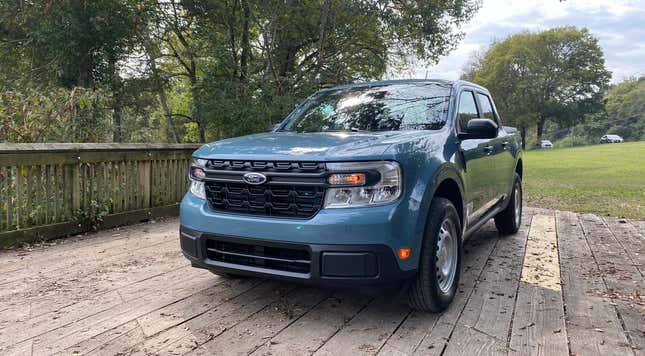
Honestly, this is the part of the Maverick I’m least excited about, but it’s not like it’s terrible; it looks good enough, but I just don’t think the exterior design is necessarily amazing.
I broke down the exterior design in an earlier post already, but in speaking with the Maverick team, I learned about a couple of interesting design influences you might like to know about.
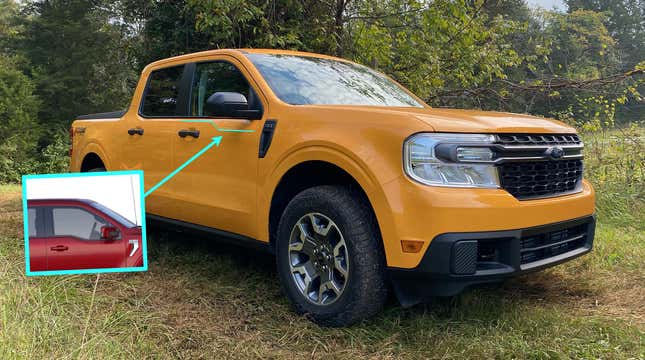
First, there’s a little character line in the door, under the beltline that’s deliberately designed to suggest the Ford F-150's distinctive jogged window line. It’s subtle, but a nice little tie-in to the Ford truck heritage.
Slightly more obscure and more interesting is where they took inspiration for the “dog bone” design that shows up in multiple locations on the car, most prominently in the bar that houses the front turn signals on the grille:
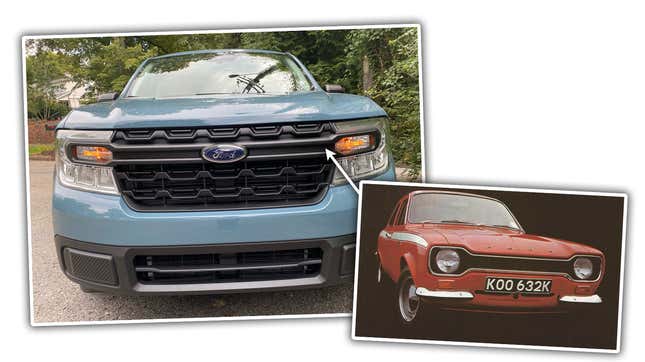
That was actually inspired by the amazing old British Ford Mark I Escort, with its signature dogbone grille. I’m not exactly sure if that makes the front end of the truck look any better, but it does make me appreciate it a bit more.
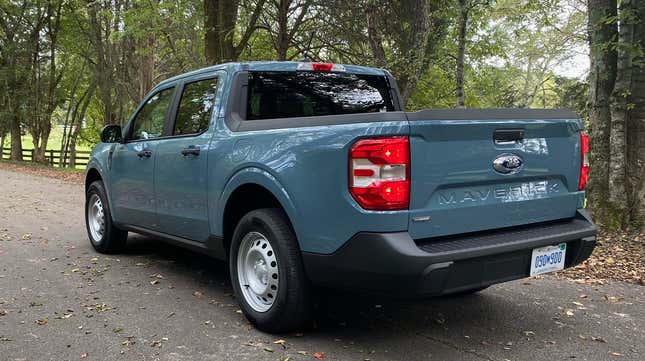
Overall, the look of the Maverick is clean and modern, and there’s nothing offensive about it, really. I think it looks strongest from the rear quarter, where you get nice details like the transition from cab to bed, which I think was handled nicely, the repeat of the general dogbone shape in the tailgate stamping, and — a little detail I like that you hardly ever see on modern cars or trucks — the off-center license plate mounting.
Plus, the Maverick really brings it when it comes to colors:

While not all colors are available in all trims (I really wish the yellow-orange was on the base XL trim) there are good, real, non-grayscale colors available, something our automotive culture absolutely needs more of.
Visual differentiation between trims is mostly a matter of wheels and colors and minor trim details like body-colored or black door handles, and in almost all of these cases, I think I prefer the lower specs.
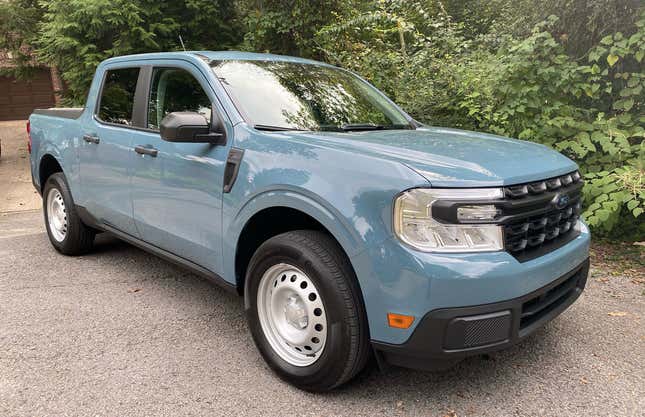
I’m an absolute fool for basic steelies like these on the base car, and I think the black of the door handles provides nice contrast. It doesn’t feel cheap to me, it just feels right.

There’s some minor lighting design differences between the lower and upper trims, too, with the XL’s headlights lacking that upper section’s LED signature light/DRL, and the turn indicator dogbone trim being black instead of silvery. But, really, those are pretty minor differences.
As far as the scale of the truck goes, it’s definitely not a big truck, but it’s not ‘80s minitruck tiny, either. If it helps, here it is near a Toyota Sports 800 and a Skoda 110MB:
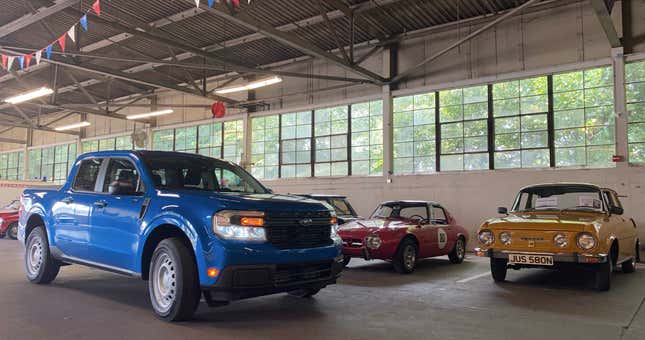
Those sure make it look big. If those references aren’t familiar enough, how about a Triumph Spitfire?

That help? You know what’s a better example? An old Datsun truck, which is pretty close to the same length as the Maverick, and this slightly lifted one was about as high, just a bit leaner, overall:

It’s actually quite a reasonable size. It’s not small, but not so big that driving is a pain. Think Honda Pilot sized.
The Interior

While the exterior design is good if not necessarily amazing, I think some really great work has been done on the inside of the Maverick — which is where most owners will spend their time, anyway.
I spoke a lot with Scott Anderson, the Interior Design Manager, and was very pleased with what he told me about the design goals for the interior. First and foremost was about honesty of materials.
This is an important concept to me, and what it essentially means is that materials shouldn’t pretend to be something they’re not. Lots of plastic was used in the Maverick, and that plastic is unashamedly plastic — it’s not trying to fool you into thinking it’s leather with fake texturing or absurd molded-in stitching.
It’s just plastic with good textures molded in and clever design. The door panels are a great example of this:
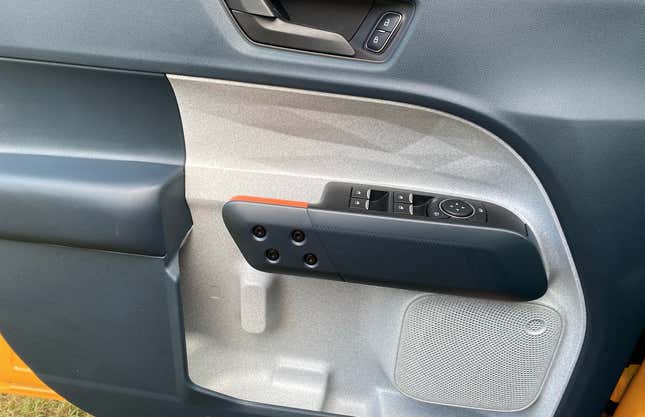
So, one thing I learned talking to Scott was that the target buyer for this vehicle seems to need a car to carry around the absurd amount of bottles they travel with. There’s so much bottle storage in this thing, because Ford’s research showed that, well, people have a shitload of bottles.
As a result, the door pockets are capable of holding like four bottles, ranging in size from normal water bottles to big-ass thermos-like beasts. As a result, the door pockets are cavernous and capable of holding other things, in the unlikely event you have non-bottles in your possession, too.
The open design also necessitated that interesting cantilevered armrest/door handle, and if you look at that you’ll spy something that’s also important to me: exposed fasteners.
I’m all for the unashamed exposing of fasteners; it’s ridiculous carmakers are always trying to hide them. They’re fine.
Scott told me that getting sign-off on exposed screw heads like that was a massive fight, and he finally won by having Ford’s supplier make really cool, custom hex-head screws that say FORD on them:
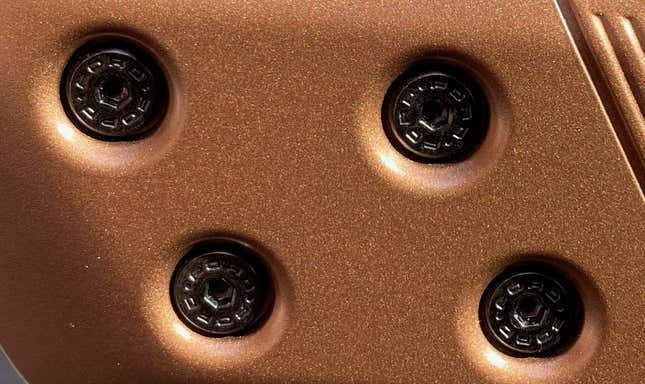
They’re cool! And if you have to remove them to replace the armrest or something, you can see right were they are, and there’s no silly little plugs or caps or whatever. This is a triumph.
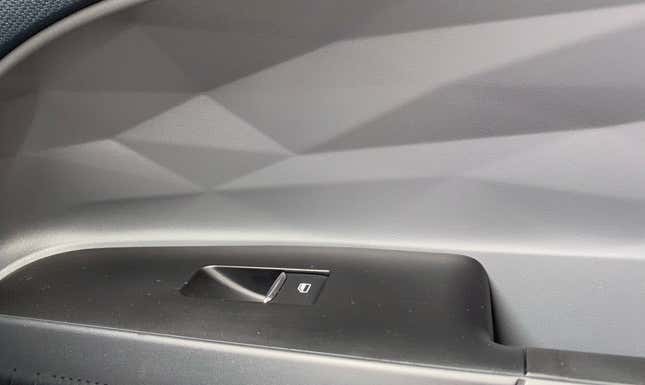
This low-poly, late ‘90s 3D type of patterning is a theme that extends throughout the interior, and I like the way it looks. I suppose it may become dated, but that’s part of the charm.

Clever interior design helped keep the costs down for the Maverick, and you can see that in parts like this center console, which I was told uses significantly less parts than a more conventional design, and from my experience, those discarded parts are ones I never missed.
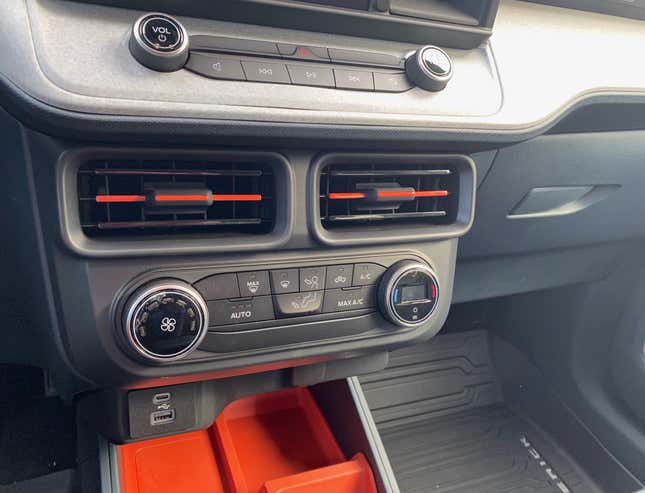
Higher-spect trims add some bits of color and varying materials to the basic design, but they’re all fundamentally the same, and they all work well.
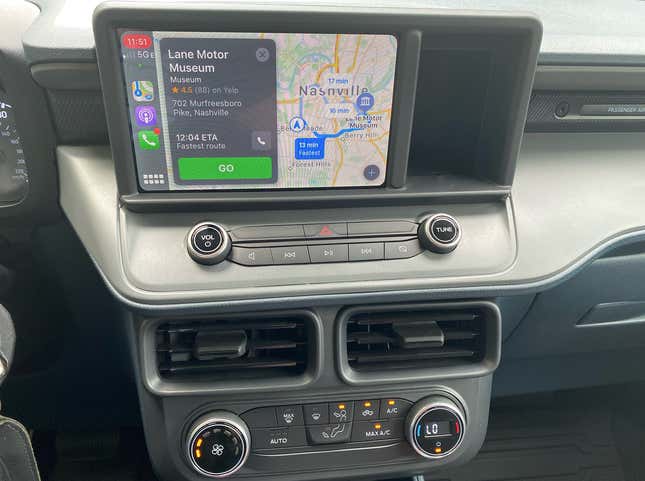
You may also be noticing something else about this dashboard that’s not quite like a lot of the recent cars we’ve been reviewing: there’s plenty of knobs and physical buttons, and they’re almost all in the places you expect them, doing the things you expect them to do.
Sure, all trim levels come with a decent-sized touch screen there, but there’s a volume knob and a tuning knob and big chunky knobs for fan and temperature, all immediately available without having to poke through menus or other bullshit. It’s all simple and immediately understandable and refreshing.
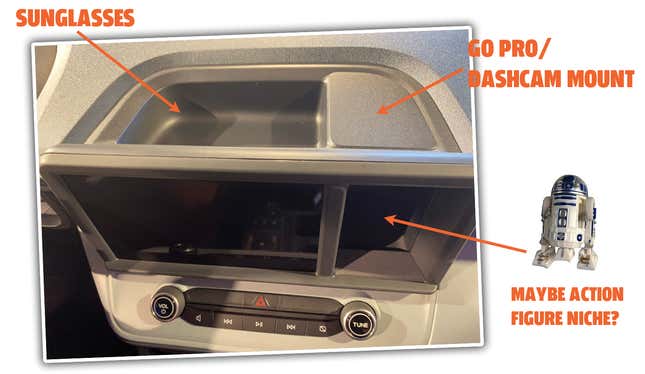
There’s some nice clever touches as well, like a special suction-friendly GoPro/dashcam mounting point next to a well I was told was for sunglasses. There’s also that little chamber next to the touchscreen, but I can’t really figure out what that would actually be used for beyond maybe a nice little niche for a favorite totemic action figure?
The inside is quite roomy, being essentially a big box, and the floor is quite flat, which, along with the more upright seating position, gives lots of legroom in the rear, especially.

That’s the base XL trim. The Lariat gives more interior color and leather upholstery:
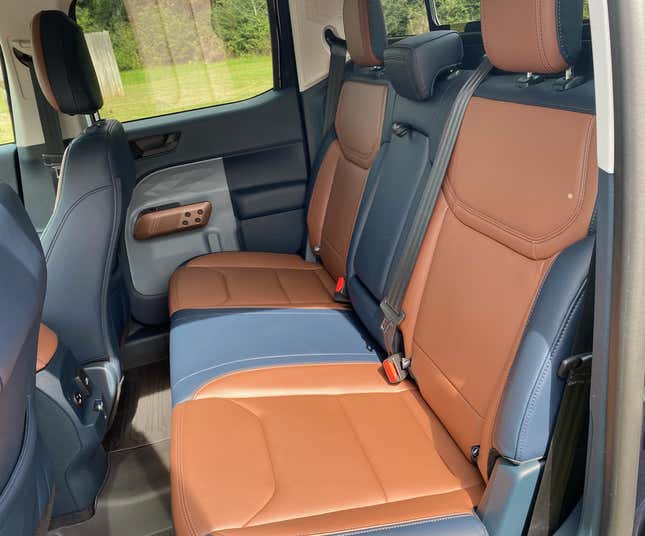
The underseat storage at the rear is good, even in the hybrid version, which stores its 12V battery there (cover removed in the pic), The gasoline-only 2.0-liter version has two full-sized compartments:
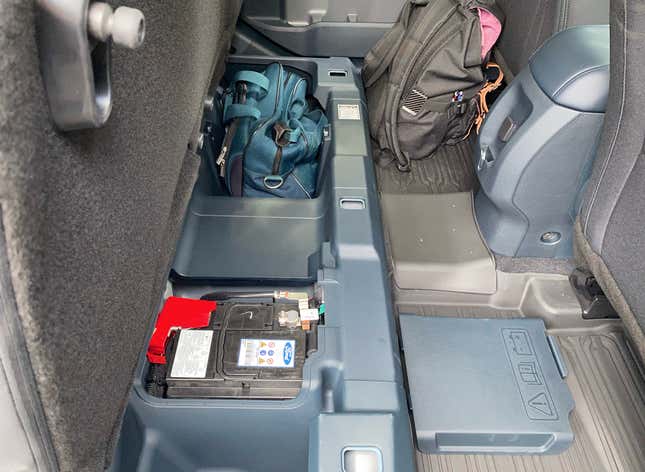
I was able to fit my whole overnight bag under there with no problem. The rear seatback also folds down to give access to the jack and maybe store a laptop bag back there, though I was told it wasn’t designed to fold completely flat.
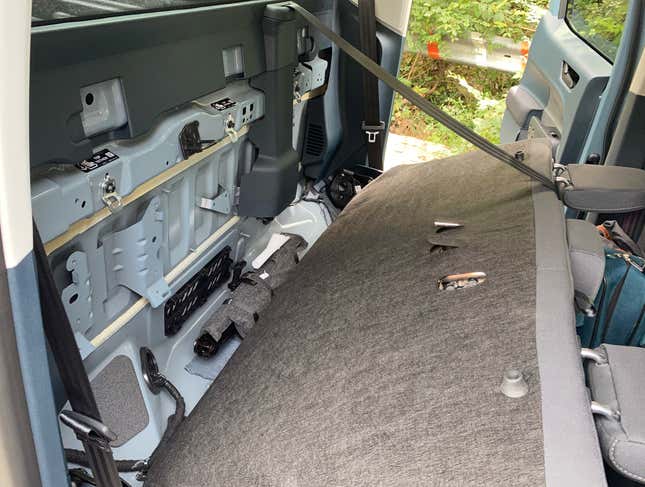
It seemed to get pretty close to flat, and I’d think if Ford is looking for a way to improve this next model year, letting that seatback fold into a real cargo platform would likely be a welcome addition.
I thought the interior was plenty comfortable, the dash and controls were gleefully basic and usable, and there was plenty of room for both humans (even real humans of normal human size, unlike myself) and all their stuff.
Including bottles. So many fucking bottles.
Let’s Go To Bed

If you’re looking for that Roland Barthes-style punctum of the Maverick, that one part that really defines what this thing is, then it has to be the bed.
Sure, it’s a pretty short bed for a pickup, but in this era of massive double-cabs, a smaller bed space is hardly uncommon. What makes the Maverick’s bed so special is how much thought and consideration Ford put into thinking how people would use it, and how accessible they made the ability to use it.
They call it Flexbed, and while I’m not sure I’ll remember to call it that, it’s a valid descriptor. The first clue you get to just how well Ford thought through the ways people may want to use their vehicles is actually in the glove box, where you’ll find some wire in a plastic bag:
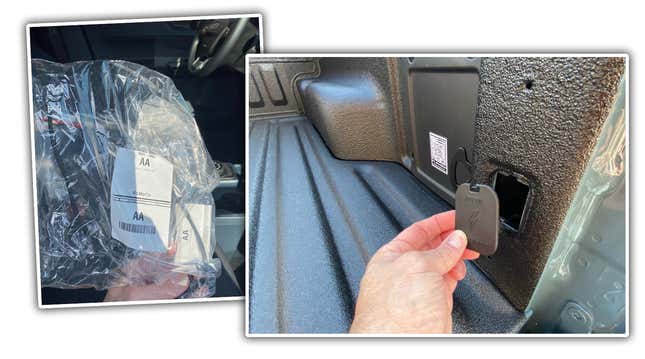
All Mavericks come with this bit of wire, which is a 12V pigtail. If you go to the back of the truck, you’ll see on either side is a little pop-out panel with a connector that gives access to the car’s 12V of sweet, sweet electrons.
By providing easy access to those 12V, Ford is enabling people to be able to add useful features to their trucks without messy and potentially dangerous hacks like tapping into the taillight or whatever.
Even better is the fact that, right there in the bed, on a little sticker next to the panel, is a QR code. Scan it, and it takes you to Ford’s site that’s full of clear, easy DIY instructions, complete with materials lists and step-by-step guides to show you exactly how to do things. For example, here’s one showing how to add LED bed lighting and a cheap air compressor into the bed:
Ford said they plan to keep adding more of these DIY videos, and from what I’ve seen so far, they all look useful and give real, usable options for people who want to do specific things but don’t want to spend a bunch of money on truck accessories if they don’t have to.

Take the bike rack one there; a bike rack that does what the DIY one does goes for about $250; the Ford solution costs maybe $20 or so in parts, and it does the job just fine thanks to some clever bed design built into the truck that has slots for 2x4s to be easily mounted for stuff like this.
I saw this bike rack completed at the event, and it sure looked like it’d do the job just as well as that $250 one:
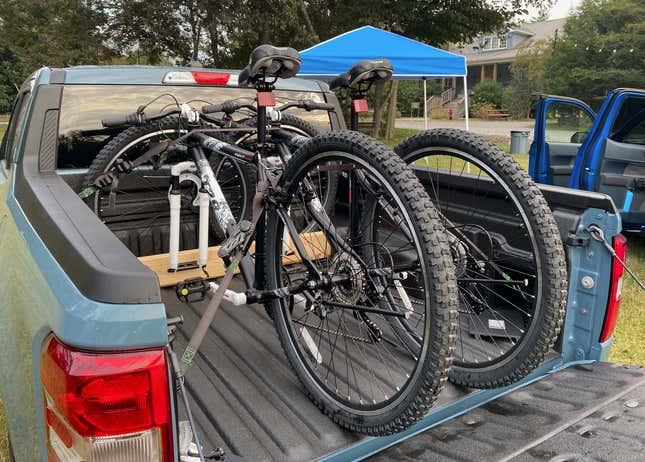
Those slots for wood planks can also act as cargo dividers, and there’s threaded holes in the bed for DIY side rails and other cargo securing systems.

It’s clear that someone—or, likely, many someones—really thought this through and actually gave a shit about making this bed as usable as possible, as affordably as possible, which is key for a truck with a sub-$20,000 starting price.
There’s a realization I’ve come to in life that tells me that what gets in the way of doing things are little things that you don’t want to do, and the beauty of a little truck like the Maverick is that it helps remove the little ass-pain things that stop you from doing the things you want.
The little things that stop you don’t have to be huge; they just have to be just pains in the ass enough. They’re the reason why you don’t go see your friends on the other side of town because it’s just such a hassle to get there. They’re the reason I don’t take my shitty canoe out more often, because it’s a pain in the ass to heave onto the roof of my Pao without scraping something.
I do it, sure, but if I could just drag that canoe and shove it in the bed of a truck and quickly tie it down to some convenient points then, yeah, I’d do it a lot more, because it would mean 5 minutes of prep instead of 30.
Oh, and the tie-downs are bottle openers, too:
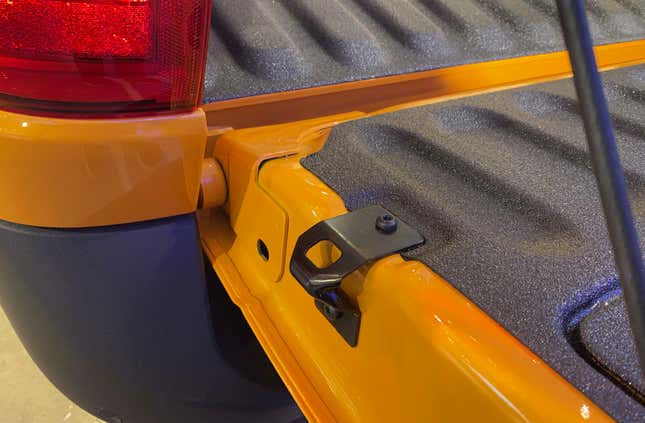
This is a vehicle that, far more than an SUV or crossover, will make doing things easier. See something on the side of the road that you could use in a project? Grab it and chuck it in the back. Picking up filthy things? Who cares, it’s a truck! Going out to a festival or or the beach or camping or just spending an afternoon outdoors with friends and food and chairs and whatever? A truck makes all this easier.
We all know this. And that brings us to traditional Truck Things, like hauling 4x8 sheets of plywood, which the Maverick can do despite its short bed, because there’s a midway setting for the tailgate that lines up with the wheel well tops to allow for easy stacking of all that plywood you love so damn much:

I drove the plywood-filled truck a lot and tried to shake things loose a bit. It all held just fine.
As far as how much that bed can carry, Ford says it’ll hold 1,500 pounds, but as we know, actual payload depends on all the other weight in the car, so that number will vary depending on how the truck is equipped.
I checked the doorjamb stickers on many of the Mavericks I tested, and found a range from 1,329 pounds to 1,563 pounds.

The higher-spec, more equipped versions naturally will haul less, the lower-spec ones more. I’d say the 1,500 pound payload estimate is entirely reasonable.
If you want to tow with your Maverick, you absolutely can. The base level of towing is 2,000 pounds, and with the gasoline 2-liter engine and an option package that includes a bigger radiator, bigger cooling fan, heavy duty transmission with a transmission oil cooler, and a higher final drive ratio, the Maverick can tow up to 4,000 pounds.

I towed this Airstream trailer on the highway, and it felt stable and confident while the acceleration was still decent. I could feel that I was towing a heavy camper, but it wasn’t much of a chore at all. I’ve had far, far worse towing experiences.
I can see the base spec of these trucks being really popular for gardeners who tow riding mowers and other equipment, for example. Why spend F-150 money when this would do everything you’d need and be easier to maneuver through narrow neighborhood streets in cities like Los Angeles? It makes a lot of sense.
What’s It Like To Drive (And Let’s Talk About MPGs)
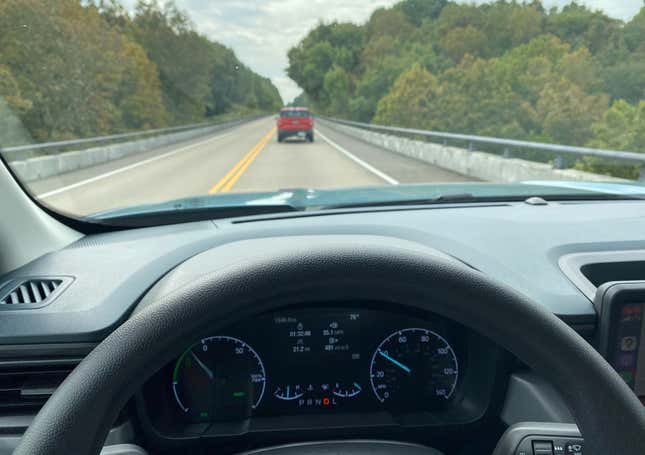
I’m guessing most buyers won’t be taking their Mavericks to track days, though to be fair, I’ve not only brought worse cars to them, I’ve brought worse Fords. Speed and handling aren’t what this thing is all about, but I’m happy to say that they’re also just fine for what it is.

Neither engine offered has a silly plastic engine cover, I’m happy to say, by the way.
The hybrid’s 2.5-liter Atkinson-cycle engine makes 162 hp on its own, and with the electric motor the whole system makes 191 hp, and 155 lb-feet of torque. I thought it felt plenty peppy and had no issues getting to highway speeds or passing or anything, really.
It uses a planetary-type CVT, and unlike many CVTs I’ve driven, I was able to forget it was a CVT, which is the highest praise any CVT can hope for.
The hybrid’s battery is a small 1.1 kWh unit, and the Maverick can travel in EV-only mode at low speeds for short periods, which is handy if you’re moving it around an enclosed garage or warehouse and prefer to avoid asphyxiation.
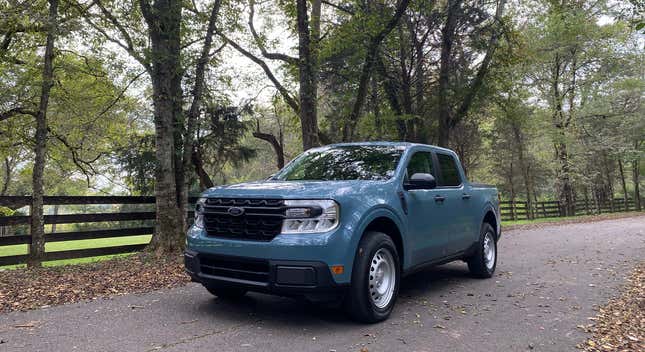
The 2-liter gasoline inline-4 makes 250 hp and 277 lb-ft, and while it is noticeably quicker, I just never found it different enough to really care about, and certainly not enough to give up the fantastic MPG I saw while driving.
Getting 35+ MPG was trivial, even with me doing my usual drive-like-a-dickhead-to-feel-how-it-feels test drive regimen. When driving like a sane person, hitting 40 was easy, and if I wanted to really self-flagellate and hypermile it, I’m confident I could have squeezed 55 or more because, you know, I’m a pro at that.
The 2-liter gas-only Ecoboost engine got about 25-29 MPG or so. Respectable, sure, but the hybrid’s ability to hit near-Prius numbers without significant compromises is fantastic.
There’s a 4x4 option available, too, with skidplates and everything, and while I don’t necessarily think off-roading will be a huge use for these, they seem at least as capable as most mainstream 4x4 SUVs, and I bet could be made to be even more capable.

The short off-road course we had to try the Maverick out on wasn’t really terribly challenging, but it showed that the Maverick could handle most basic off-road stuff just fine. I would have liked to have tried taking the base-model 2WD one on the course to see how it did, but Ford wasn’t down with that.
Electronics And Those Kinds Of Toys
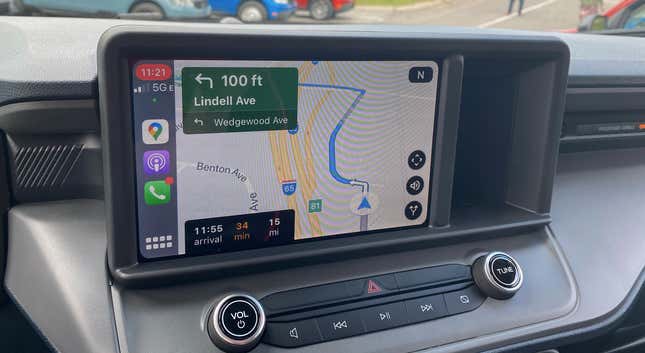
Okay, first off, if your thing is the latest high-tech whatevers in your car, this probably isn’t the vehicle for you. If you don’t believe me, look at this:
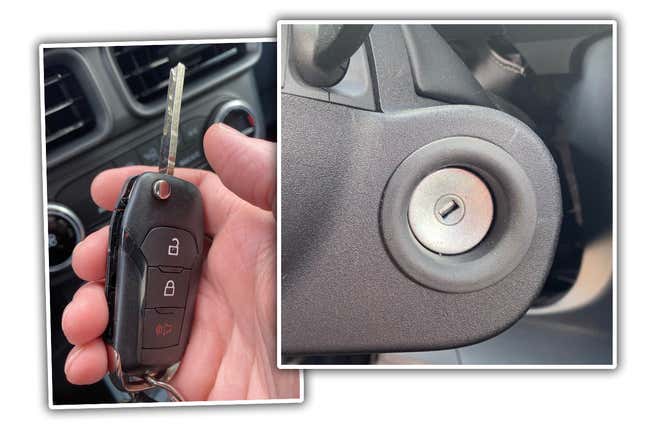
A key! A real key! Sure, there’s a fob with remote locking/unlocking, but you have to physically insert a key into the car to start it, and I kind of love that. I think proximity keys are often more hassle than they’re worth, so I’m happy to do the old shove and twist.
If you really want to start your truck with a button and keep your key in your pocket, the Lariat spec has that. As far as other electronic things go, the Maverick has all the essential bases covered: Apple CarPlay and Android Auto (cable required, though), auto headlamps, optional 4G wireless hotspot, USB ports front and rear (including both C and old-school USB), optional 110V outlets in the rear and the truck bed, automatic emergency braking, and so on.
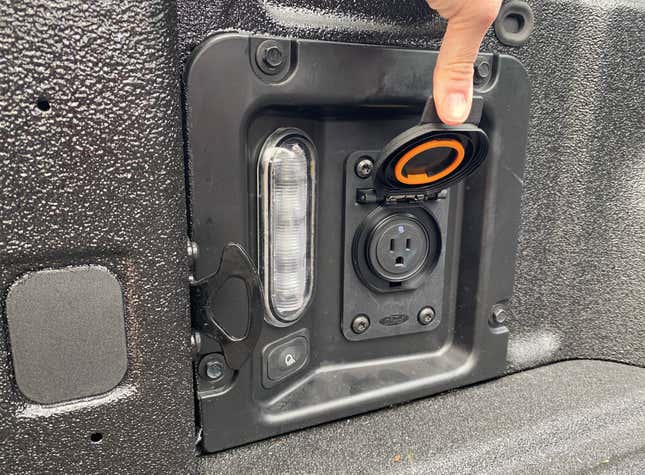
I suppose you could wire up a DIY inverter for the 110V plug in the bed, but there’s a module with one and an LED bed light that you can option that uses one of those cubbies at the rear. And, it keeps the 12V pigtail usable for other needs, too.
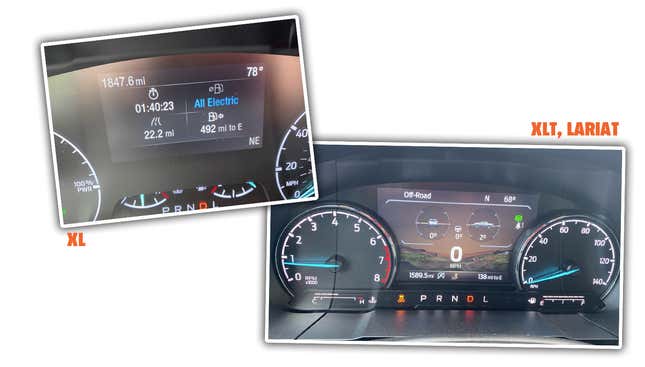
The only thing the base model lacks that I think some people might consider essential is cruise control, adaptive or otherwise. The base XL model also has a smaller LCD screen in the instrument cluster, one-zone climate control instead of two, lacks a wireless charging pad, and a few other omissions, none of which I’d really think are crucial, personally.
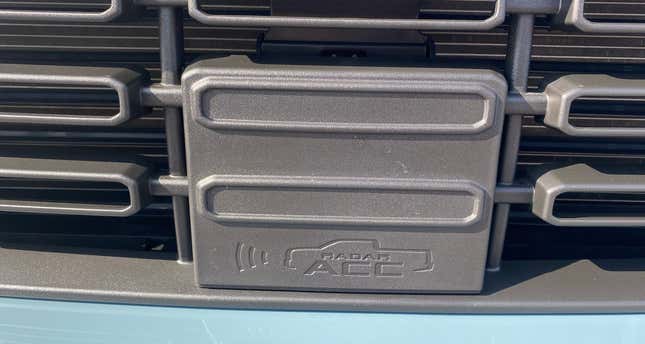
The one I did like is the power back window control, because it’d be nice to be able to open and close that little back window from the driver’s seat, but that’s hardly a deal breaker.
The Maverick has the essentials demanded by modern car buyers, and I really don’t think most buyers would find anything seriously lacking.
Value And Overall Take
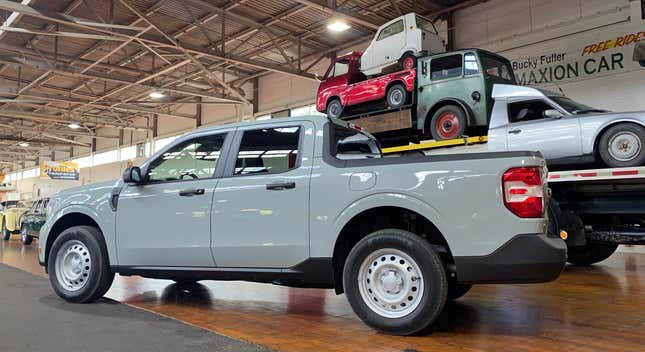
In case I hadn’t made it clear, I love this thing. It’s fantastic and fills a hole in the car market that has desperately needed filling: not just the hole for a small, affordable truck, but the hole for a small, affordable, do-anything family vehicle that gets great gas mileage.
I meant it when I said this thing should be competing with RAV4s and CR-Vs and Rogues and Tiguans and Escapes and all those other indistinguishable crossovers. In a rational world, the Maverick will eat all of their lunches, lustily and sloppily.
The base model starts at $19,995, the XLT is $22,280, and the Lariat is $25,490. Even the top-spec one is cheaper than most mainstream crossovers. I think the sweet spot is any of the hybrid ones, especially the base one, because I have a perverse love for low-spec cars.
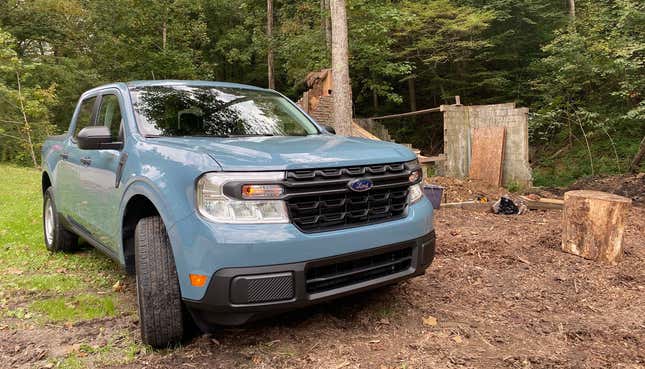
I love the honesty of the Maverick, the flexibility, the way it’s been thoughtfully designed to help you customize it and update it on your own with crap you can buy from the local hardware store. I love that it’s been designed to be cheap to run and fuel, and that it’s unpretentious and fun and should be the sort of transportation tool that actively increases the scope of what you can do with your life.
The Maverick has the potential to be a humble yet dignified companion to a person or family, a reliable resource that doesn’t need to be babied or require undue attention. A vehicle that opens doors to do more things, easier. These are all qualities I admire in cars, and I’m delighted to see a major automaker finally selling something like this.
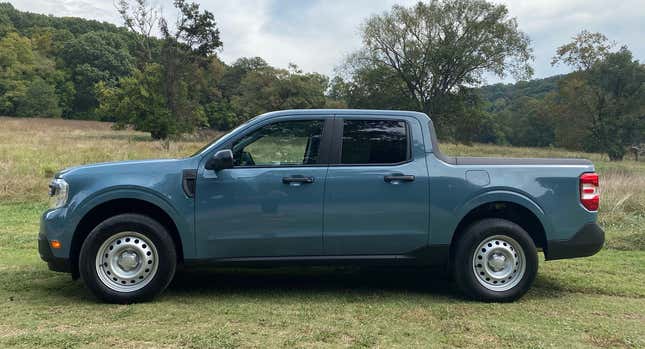
So, if you’re looking for a family car, a crossover, an SUV or whatever, and you’re just not that thrilled with your options, then I say it’s time to pivot and consider this useful almost-little truck. Save your money and get something that’ll do all you could have done in a crossover, but easier, better and more.